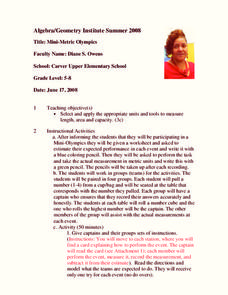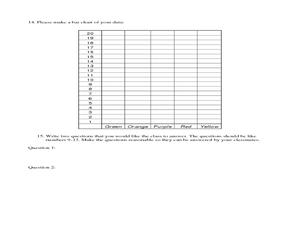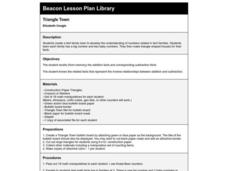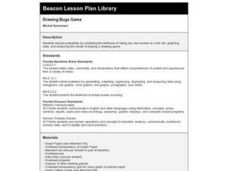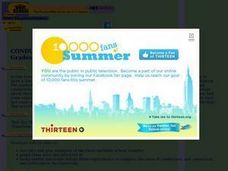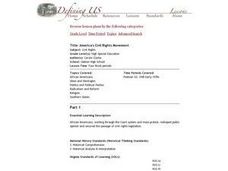Curated OER
A Plop and Fizz
Seventh graders perform an experiment to determine the effect of temperature on reaction rates. In this chemistry lesson, 7th graders take measurements and record data. They create a graph and analyze results.
Curated OER
Squares, Square Roots, and Exponential Expressions
Students explore the concepts of square roots and exponential expressions. In this square root and exponential expression lesson plan, students complete an investigation called Building A Square Patio. Students use color tiles to develop...
Curated OER
Rate of Solubility
Students investigate factors affecting the rate of solubility. In this rate of solubility lesson plan, students experiment by crushing, heating and cooling solutes and solvents to see how the solubility is affected. For each situation,...
Curated OER
Mini-Metric Olympics
Young scholars participate in a Mini-Olympics with measurements. In this measurement lesson, students throw items and predict how far they will go. They measure the actual distance and find the difference between that and their...
Curated OER
Probability
In this probability worksheet, students determine the empirical probability based on specific sample data. The one page worksheet contains three problems. Solutions are provided.
Curated OER
Using Ratios to Taste the Rainbow
Students solve problems using ratios and proportion. For this algebra lesson, students analyze skittles and their different colors as they apply the properties of ratios and proportions to solve their problems.
Curated OER
Investigation: Reasoning and Proof
Students explore animal characteristics by creating illustrations. In this animal identification lesson, students read a list of animal descriptions which they draw using crayons or colored pencils. Students view their drawings and...
Curated OER
Circles to Spheres
Students investigate circles and spheres. In this space shapes lesson plan, students compare and contrast two-dimensional and three-dimensional shapes. Students investigate the relationship between plane and space shapes.
Curated OER
Triangle Town
Second graders create a fact family town to develop the understanding of numbers related in fact families. They learn each family has a big number and two baby numbers. They make triangle shaped houses for their facts.
Curated OER
Fraction Frenzy
Second graders identify fractions as part of a set. They explain concrete and symbolic representations of whole numbers, fractions, decimals, and percents in real-world situations. They complete a web-based cookie baking lesson.
Curated OER
Drawing Bugs Game
Second graders explore probability by playing a drawing game with dice. After they roll a die, they draw a tree diagram to illustrate each of the possible outcomes.
Curated OER
Conduction, Convection, Radiation, Oh My!
Learners draw a line graph, and use graphing as a tool to discover more about conduction, convection and radiation. They should design their own experiment using heat sensitive paper to show they explain these 3 processes.
Curated OER
Fun With Food
Learners participate in hands-on scientific experiments relying solely on household kitchen materials.
Curated OER
Sound
Students identify sources and importance of sound, discuss sounds heard on way to school, explain why sound waves can be "seen", and participate in various classroom activities and experiments that illustrate how sound travels.
Curated OER
Properties of Salt
Students discuss certain properties of salt and how it is used every day as well as harmful uses. They experiment with salt to see it conduct electricity, form crystals and water freezing temperature. They complete a worksheet to record...
Curated OER
Water Cycle Terrariums
Students explore the water cycle. They build a model of the water cycle in the form of a terrarium and explain how it demonstrates the water cycle. In addition, they draw a representation of the water cycle demonstrated in the terrarium.
Curated OER
Change It
Fourth graders expand their knowledge about how the physical properties of a substances can be changed. They are given multiple opportunities, using first-hand experiences and familiar objects in different contexts, to identify...
Curated OER
Erosion Lab
Eighth graders explore variables that influence the rate of erosion due to the 4 major agents. They work as a group and practice conducting experiments according to the scientific method. Students comprehend that communicating ideas...
Curated OER
America's Civil Rights Movement
Eleventh graders explore, analyze and study the background to America's Civil Rights Movement through the court system, mass protest, public opinion, political cartoons and legislation. They research Rosa Parks, Brown vs. Board of...
Curated OER
Understanding Weather
For this science worksheet, students examine the topic in order to solidify knowledge covered in the curriculum using puzzles and creative games.
Curated OER
Division 1-5
Six pages of various division problems are included in this packet. Questions include short answer, multiple choice, word problem, and filling in tables. Your class will get adequate division practice after completing these 30+ problems.
Curated OER
Activity Plan Mixed Ages: Friendship Soup
Students learn creative cooking. In this early childhood lesson plan, students children work together to plan, buy, and prepare a soup for their lunchtime meal.
Curated OER
Polymer
Students investigate polymers by completing 3 experiments. In this polymer lesson plan, students mix plastic with acetone, they create polyurethane foam, they make slime and build a polymer model once their polyurethane foam is set. ...
Curated OER
Stuffed Animals Measuring
Learners measure stuffed animals with various materials such as dog biscuits, paper clips, and yarn. In this measurement lesson plan, students measure the stuffed animals, and understand the concept of long and short and big and little.





